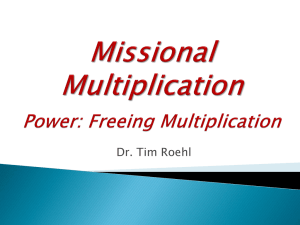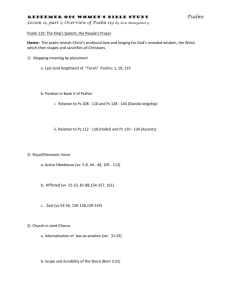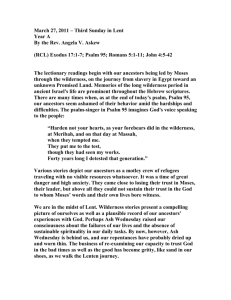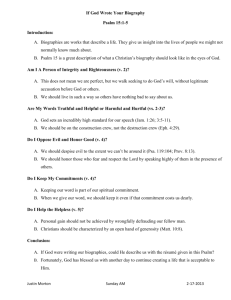Week 04 - Grace Episcopal Church
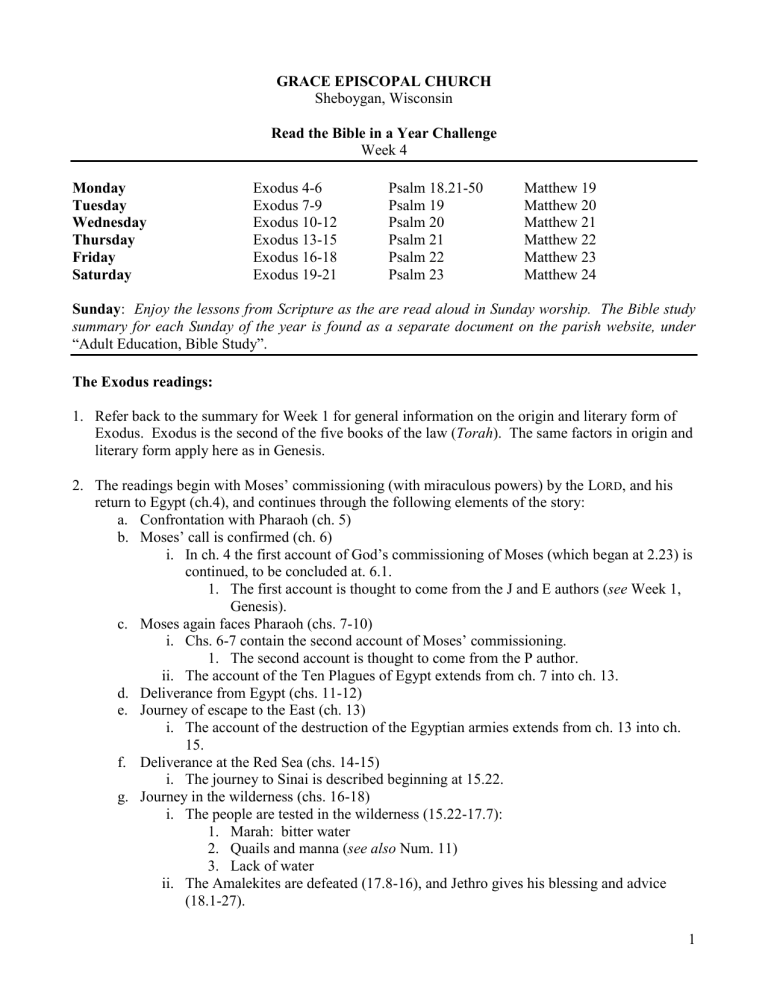
GRACE EPISCOPAL CHURCH
Sheboygan, Wisconsin
Read the Bible in a Year Challenge
Week 4
Monday
Tuesday
Wednesday
Thursday
Friday
Saturday
Exodus 4-6
Exodus 7-9
Exodus 10-12
Exodus 13-15
Exodus 16-18
Exodus 19-21
Psalm 18.21-50
Psalm 19
Psalm 20
Psalm 21
Psalm 22
Psalm 23
Matthew 19
Matthew 20
Matthew 21
Matthew 22
Matthew 23
Matthew 24
Sunday : Enjoy the lessons from Scripture as the are read aloud in Sunday worship. The Bible study summary for each Sunday of the year is found as a separate document on the parish website, under
“Adult Education, Bible Study”.
The Exodus readings:
1.
Refer back to the summary for Week 1 for general information on the origin and literary form of
Exodus. Exodus is the second of the five books of the law ( Torah ). The same factors in origin and literary form apply here as in Genesis.
2.
The readings begin with Moses’ commissioning (with miraculous powers) by the L
ORD , and his return to Egypt (ch.4), and continues through the following elements of the story: a.
Confrontation with Pharaoh (ch. 5) b.
Moses’ call is confirmed (ch. 6) i.
In ch. 4 the first account of God’s commissioning of Moses (which began at 2.23) is continued, to be concluded at. 6.1.
1.
The first account is thought to come from the J and E authors ( see Week 1,
Genesis). c.
Moses again faces Pharaoh (chs. 7-10) i.
Chs. 6-7 contain the second account of Moses’ commissioning.
1.
The second account is thought to come from the P author. ii.
The account of the Ten Plagues of Egypt extends from ch. 7 into ch. 13. d.
Deliverance from Egypt (chs. 11-12) e.
Journey of escape to the East (ch. 13) i.
The account of the destruction of the Egyptian armies extends from ch. 13 into ch.
15. f.
Deliverance at the Red Sea (chs. 14-15) i.
The journey to Sinai is described beginning at 15.22. g.
Journey in the wilderness (chs. 16-18) i.
The people are tested in the wilderness (15.22-17.7):
1.
Marah: bitter water
2.
Quails and manna ( see also Num. 11)
3.
Lack of water ii.
The Amalekites are defeated (17.8-16), and Jethro gives his blessing and advice
(18.1-27).
1
1.
The Amalekites are a fierce tribe mentioned at Gen. 14.7; Num. 13.29 and
14.25. Moses defeats them using the rod used to defeat Pharaoh. a.
The L ORD fights for Israel when the rod is raised.
2.
Just as Jethro had met Moses, when Moses escaped from Egypt, now he meets Israel. a.
Jethro, a non-Israelite, recognizes the L ORD as the all-powerful God. b.
Jethro has different names elsewhere (Reuel at 2.18; Hobab in Judg.
4.11). These different names reflect different authors.
3.
God’s covenant with Israel (chs. 19–). This section concludes in ch. 24. a.
Israel encounters the L
ORD at Sinai, and receives the Law (the Ten Commandments). b.
The section of the Law described by scholars as the “Covenant Code” begins at 20.22 and concludes at the end of ch. 23. i.
In this code (a series of injunctions) are found issues which relate to the proper governance of Israel as God’s chosen people.
1.
These injunctions have a strong ethical import, relating to proper conduct in community, and include issues of the regulation and protection of property ownership, restitution for wrong, and sexual ethics.
2.
The code includes the famous lex talionis (“an eye for an eye”) of retribution.
The psalms: The psalm numbering and versification system used throughout these study summaries is that found in The Book of Common Prayer (1979).
1.
Refer back to the Week 1 summary for general information on the literary form and theology of the
Psalter.
2.
The psalms encountered this week include: a.
18.21-50: Continuation of a royal hymn of thanksgiving. i.
In part I of the psalm, God’s intervention to save the king from his foes was described. ii.
In part II of the psalm God is described as equipping the king with strength to triumph over his foes. b.
19: A psalm in two parts, with vv. 2-7 being a creation hymn and vv. 8-15 being a wisdom hymn. i.
The Law (extolled in the wisdom section of the psalm) is thus seen as a creation of
God. c.
20: A royal psalm, a prayer of the people that God grant the king victory in battle. d.
21: A royal hymn of thanksgiving. e.
22: An individual lament, the opening line of which is cried out by Jesus on the cross (Mtt.
27.46; Mk. 15.34). i.
Question : Is Jesus expressing genuine despair, or is He beginning to recite a psalm which ends with a note of God’s triumph, and dies before He reaches the end?
ii.
The final verse rendering of “deliverance” may also be rendered as “salvation”. f.
23: Perhaps the best-known psalm. i.
Compare Psalm 23 to Mk. 6.30-44 (the miracle of the loaves and fishes).
1.
Although Jesus is described in a “lonely place” (Greek = aramón , a
“wilderness,” as in a desert), the people are described as sitting in companies on the “green grass”!
2
a.
Jesus is described as taking pity on the crowd, because they “have no shepherd”.
The Gospel readings:
1.
The readings this week include Jesus exercising authority (teaching) and inviting the people to become His disciples (19.1-22.46). a.
Notable teachings are given on divorce, and parables are frequent. Jesus emphasizes the cost of discipleship. b.
Jesus predicts His own passion, and the disciples continue to look for personal gain (20.20-
28). c.
Jesus enters into Jerusalem, and disputes over His authority arise with the Temple authorities.
2.
The narrative shifts from teaching and disputes to a series of woes, and to teaching about the end of this age. Ch. 23 marks the beginning of this shift, concluding with a lament over Jerusalem.
3.
At 19.16-30 Matthew tells the same story found at Mk. 10.17-31 and Lk. 18.18-30. In Mk. and Lk.
Jesus says that only God is good. Mtt. renders this as “One there is who is good” (19.17). a.
Compare Jn. 1.1. b.
What might Jesus’ tone of voice be? Is He testing the young man?
4.
When Jesus is tested about paying taxes to Caesar (22.15-22) He refers to the inscription on the coin. a.
Each emperor had new coins minted. The coin shown to Jesus would, therefore, have read
“Tiberius Caesar, Son of the divine Augustus, great high priest.” i.
Jesus is making a point more about idolatry than about paying taxes.
5.
The Great Commandment is given at 22.37-40. The language used is comprised of quotations from Deut. 6.5 and Lev. 19.18.
6.
The desolating sacrilege which is mentioned at the beginning of Jesus’ teaching on the end of the age (24.15) can be understood to include allusion to 1 Macc. 1.54; 6.7 (the term comes from Dan.
9.27; 11.31; 12.11). a.
The Seleucid ruler Antiochus Epiphanes sacrificed a pig on the altar of the Temple ca. 134
B.C.
3
